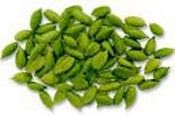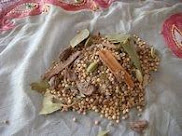
Tangy Marinated Chicken on a bed of Spicy Lentils with Coriander and Lime Relish

Home-made organic sour dough type bread
Notes from diary early October, back in Orange. Where did all these flies come from? And let’s not mention the grass. Let’s talk about Dave though. Dave lives down the hill and he has (no not a combine harvester) a bob cat. He clears and smooths out a piece of ground that was too hard to do by hand (and too hard for my doggy to negotiate). He and his bob cat also fill the remaining beds with soil – it takes them about 5 minutes. It took me 2 days just to fill one and a bit.

The soil we bought is a little sandy, I would really like to dig in some organic matter - some compost, manure or chook poo. Although I have started a compost bin, I don’t have any compost yet, I can’t find the cow manure in the long grass (I’m too scared of the highly poisonous brown snakes to look too hard) and the garden centres have sold out of chook poo. Looks like other people prepared their garden beds for sowing some weeks ago! Never-the-less, I need to do something. I purchase a bag of blood and bone and water crystals that swell up and help hold moisture in the soil, combined, these should be a reasonable substitute for compost. I sprinkle generous handfuls of each onto the soil and lightly mix it in. Now I need to water it and we still don’t have a watering system. But I do have a watering can and, donning fly veil and gum boots (wellies), up the hill I go and down again, about 10 times until I have damp soil in the 4 beds in which I am going to (finally) sow these vegetable seeds. The dog wasn’t much help!

Fly veil for protection against the swarms of flies, gum boots for (some) protection from the brown snakes, if my friends could see me now.
2 days to go before we leave again and 4 out of the 7 beds are planted and watered. I’ve also made three extra beds on the ground, lining small areas with newspaper to keep the grass and weeds out, using rocks for borders and filling them up with my organic garden soil, with blood and bone and water crystals added. I plant sweet corn, pumpkins and cantaloupe melons in each of these. I’ve also sown snow peas, sugar snap peas, 3 different varieties of beans, cucumbers, rainbow chard, bloomsdale spinach, lots of radishes, spring onions, rocket, lettuce, bok choy, red pak choy, zucchini, zucchetta, turnips, carrots, beetroot, aubergines, capsicums not mention some herbs and garlic to keep the bad bugs away. There is no fence around them yet, but I figure that until they’ve grown a little there is nothing for the hares to get at. Need to get a watering system in though because the soil will need to be kept moist for germination to occur and it doesn’t rain often enough to do that. The weather’s warmed up (spring arrives a few weeks later in Orange compared to Sydney) so we should get a good start.
The day before we leave, an exhausted husband attaches the 4 veggie beds to a temporary watering system with a very long poly pipe and some spray nozzles. Eventually we’ll put in a drip system as this uses less water, prevents leaf burn and reduces the risk of mould, but this will have to do for now. Only the raised beds are hooked up for the moment. The sweet corn, melon and pumpkins will have to fend for themselves until we come back. They’re sown deeper than the small seeds and I’ve given them a deep watering (with mywatering can) so they should make it. Hopefully we’ll get some rain.
The cookings been good though:
Tangy Marinated Chicken on a bed of Spicy Lentils
with Coriander and Lime Relish
I concocted this dish a couple of years ago for a dinner party for guests who were unsure about Indian food. It was an enormous hit. I suppose you could call it an example of ‘fusion food’. It looks quite impressive and tastes great.
For convenience, you can prepare the relish up to 2 days ahead, the chicken can be marinated several hours ahead and the lentils and vegetables can be prepared and cooked several hours ahead too.
Serves 4
Preparation: 30 minutes Marinating time: 30 minutes Cooking time: 45 minutes
For Chicken:
4 free range chicken fillets
1 red chilli, seeded and finely chopped
1 tsp grated lime rind
1 tbsp lime juice
1 tbsp finely chopped coriander (stems and leaves)
½ tsp turmeric
½ tsp paprika
½ tsp salt
1 tbsp olive oil
For Lentils:
1 cup green lentils, rinsed and drained
2 carrots, sliced into rounds
2 potatoes, diced
2 tbsp ghee or olive oil
1 onion, sliced
2 cloves garlic
½ tsp turmeric
1 tsp salt
1 cup frozen peas
Freshly ground black pepper
4 thin slices ginger, julienned
1 tbsp chopped coriander
For Coriander and Lime Relish:
1 cup coriander, leaves and stems
1 clove garlic, roughly chopped
1 red chilli, seeded and finely chopped
2 tbsp grated fresh coconut (or 1 tbsp dessicated)
1 tsp grated lime rind
2 tbsp lime juice
½ tsp salt
Freshly ground black pepper
Chicken: Score chicken flesh lightly and place in a large bowl. Combine all the other ingredients and rub into chicken. Cover and refrigerate for 30 minutes or up to 8 hours.
Lentils: While chicken is marinating, boil lentils in plenty of water for about 30 minutes until soft but not mushy. Drain. Also, boil potato and carrot in boiling salted water until tender. Drain.
Coriander and Lime Relish: Combine all ingredients in the bowl of a small food processor and process until fine. Transfer to a bowl, cover and refrigerate until required.
Preheat oven to 200°C.
- Place chicken in baking dish, spoon over marinade and roast for 20 -25 minutes until cooked through.
- Meanwhile, heat ghee or oil in a medium saucepan and cook the onion for 2 minutes until translucent. Add garlic and fry for 30 seconds.
- Add turmeric, stir and add lentils, cooked vegetables, frozen peas and salt. Add about half a cup of water and bring all ingredients to a simmer.
- Taking care not to break up lentils and vegetables, stir though freshly ground black pepper, ginger and coriander. Simmer until thoroughly heated through and all liquid is absorbed, about 5 minutes.
To serve, ladle some lentil mixture onto deep plates, top with cooked chicken and spoon over a little relish. Garnish with extra red chillies and coriander if desired.
Home-made Organic Bread (with the help of my bread machine)
I stopped buying bread some years ago. Like much of the highly processed food available nowadays, I wasn't sure what went into it. Preservatives, flavours, stabilizers, colourings not to mention what goes onto the wheat itself - pesticides, fungicides and believe it or not, fire retardant during storage. A chemical cocktail in a sandwich! No thanks.
The house is filled with the lovely aroma of fresh baking bread most days but if that conjures of up images of me slaving in a hot kitchen all day every day, forget it. I do it the easy way - with a bread maker. This fantastic device takes the hard work out of the whole process but I don't let the machine do all the thinking, I drive it.
Once I've added the ingredients and started the machine, I lift the lid to ensure that the dough is the right texture. I add a little more water or a little more flour as required to get a soft but not sticky dough. Once the kneading stops, I often turn the machine off and let the dough double in size in its own time. Once that has happened, I punch it down and if I only want fresh bread for the two of us, I slice about a third of the dough off, shape it and put it back into the bread pan to rise again. Once it's risen to how I like it, I bake it in the machine using the bake only programme. I refrigerate the remainder of the dough, punching it down a few times until it cools enough to stop rising. I may use half of the dough the next day and the remainder the day after of even a day later, by which time it has developed some sour dough characteristics. The bread in the photo is made with dough that is 3 days old. I wouldn't keep it much longer than 4 days, but the bread tastes better as the dough matures so it's an added benefit.
This is my recipe:
250ml (1 cup) warm water
1 tsp sugar
2 tsp olive oil
3 tsp instant dried yeast
450g (3 cups) strong organic bread flour
1 level tsp fine sea salt
2 tsp bread improver*
Put the ingredients into the bread pan in the order listed. Select the french bread programme (this kneads for longer and produces a lighter loaf) and switch on. Check after a few minutes and add a few more drops of water if the dough looks too dry or a tablespoon more flour if it looks too sticky. Let the machine complete the whole programme for a fresh baked loaf or follow the instructions above for 3 small loaves over the next 3 days.
*most instant dried yeasts in the UK have an improver added.











0 comments:
Post a Comment